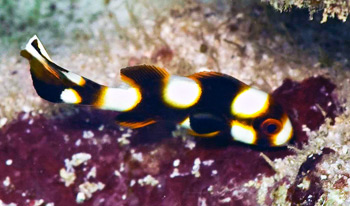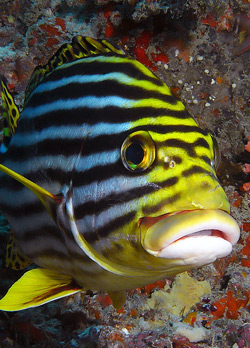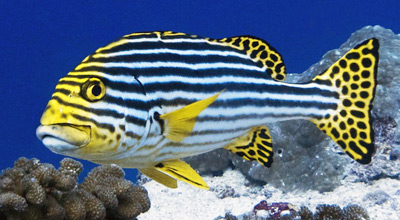I recently wrote a post about the options available to hobbyists who have unwittingly purchased a tankbuster fish. The subject of today’s post—the oriental sweetlips (Plectorhinchus vittatus)—could very well serve as the “poster fish” for that situation if it weren’t for its dismal survival record in captivity.
This Indo-Pacific species is one of several fishes that are commonly sold as adorable juveniles but have the potential to eventually outgrow most home aquariums. Of course, its tankbusting maximum size will be an issue only if you can manage to sustain a specimen to maturity—and that’s not guaranteed.
Physical traits

Juveniles of this species have an attractive brown-and-white mottled pattern, and their cute wriggling swimming style makes them nearly irresistible to the impulse shopper. Adults, which can approach around 30 inches in total length, have alternating white and black horizontal stripes on their flanks and yellow fins with black polka dots. They also have a patch of yellow coloration extending from the chin through the mouth and up to the dorsal fin.
Feeding

In addition to this species’ very large potential adult size, this is one of the major challenges in keeping P. vittatus. Captive specimens may refuse all fare offered or accept only live foods and refuse to wean onto prepared items, which can become challenging from a practical and cost standpoint. They’re also easily outcompeted at mealtimes by more boisterous tankmates.
Their diet in nature consists of motile invertebrates (crustaceans, mollusks, worms, etc.) and fishes, so items such as clams, shrimp, fish meat, mysids, and blackworms would be appropriate offerings in the aquarium.
Housing
Did I mention this fish can get within spitting distance of 3 feet in length? (I know I did, but it bears repeating!) While most individuals aren’t apt to get that large, a specimen that reaches only two-thirds of that potential size is still quite a tankbuster. To give this species the room—and dilution of pollution—it demands, you would need a tank in the several hundreds of gallons.
Compatibility
P. vittatus is a peaceful species and requires similarly laid-back tankmates that are big enough that they won’t be viewed as prey items. Small crustaceans and other small motile invertebrates are on the menu, so they should be excluded. This species won’t directly harm corals and other sessile invertebrates, but owing to its potential size and copious waste production, I wouldn’t consider it an appropriate choice for reef systems.



